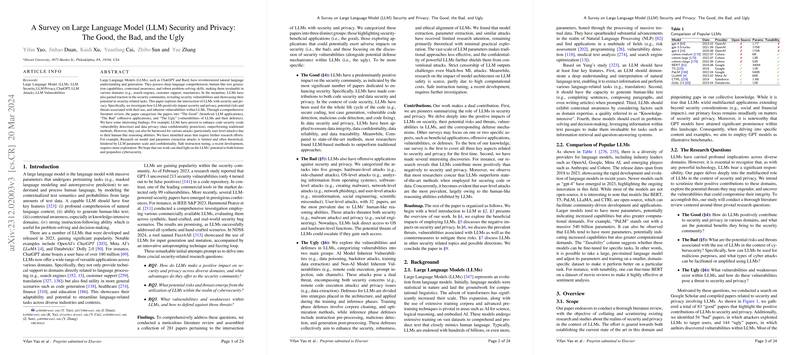An Examination of LLM Security and Privacy
This paper presents a comprehensive survey on the security and privacy implications concerning the deployment and usage of LLMs, which have increasingly become integral in various domains. Leveraging a vast literature review, the paper categorizes existing works into beneficial applications (the "good"), offensive applications (the "bad"), and inherent vulnerabilities and defenses (the "ugly"). The survey provides a structured framework to understand how LLMs can both enhance and compromise security and privacy, thereby offering significant insights for researchers and practitioners alike.
The paper begins by detailing the positive contributions of LLMs to the field of security and privacy. LLMs have demonstrated a remarkable ability to improve code security through automated code analysis, vulnerability detection, and enhanced security in software development lifecycle phases. Moreover, they have been instrumental in enhancing data security by improving techniques for anomaly detection in logs and networks and offering privacy-preserving mechanisms through data masking and cryptographic methodologies. These LLM-driven advances often outperform traditional methods and require less manual intervention, rendering them attractive solutions in a cybersecurity context.
Despite these benefits, the paper highlights the potential risks associated with the misuse of LLMs in cybersecurity. LLMs can be repurposed for offensive applications, such as generating malware, facilitating social engineering attacks, and automating phishing campaigns. This capability stems from their adeptness at generating human-like text, which can be leveraged to craft convincing malicious content or aid in devising attack vectors. In particular, the propensity for user-level attacks is accentuated, given LLMs' strength in human-like reasoning and text generation—raising concerns about misinformation propagation, phishing, and fraud facilitated by LLM-generated outputs.
Furthermore, the survey explores the vulnerabilities inherent in LLMs that pose significant security risks. These include adversarial and inference attacks, susceptibility to extraction attacks, and biases in LLM outputs that can be exploited. Such vulnerabilities underscore the need for reinforced security mechanisms, both at the architectural level and within the operational lifecycle of LLMs. The paper points out that current research efforts in inducing safe instruction tuning and enhancing model architectures are burgeoning fields ripe for exploration to bolster LLM integrity and resilience against threats.
In addressing the future trajectory of LLM security and privacy, the paper suggests that ongoing and future research should focus on adapting LLMs to traditional ML-specific tasks, replacing human efforts in security tasks, and modifying traditional ML attack strategies for LLM contexts. Additionally, it emphasizes exploring new defense strategies specific to LLMs, particularly in the light of the challenges posed by their vast parameter space and proprietary nature of advanced models, which offer barriers to traditional attack methods.
In summary, the paper serves as a critical resource portraying the dual nature of LLMs in cybersecurity—highlighting their potential to significantly enhance security practices, while also uncovering avenues where they might introduce or exacerbate vulnerabilities. The insights provided in this survey underscore the importance of a balanced approach to LLM deployment, advocating for robust security frameworks and continuous vigilance to safeguard against their potential misuse. As LLMs continue to evolve, these research directions poisedly inform cybersecurity strategy development and implementation.
